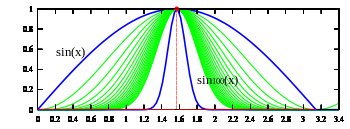Uniform limit theorem

In mathematics, the uniform limit theorem states that the uniform limit of any sequence of continuous functions is continuous.
Statement
More precisely, let X be a topological space, let Y be a metric space, and let ƒn : X → Y be a sequence of functions converging uniformly to a function ƒ : X → Y. According to the uniform limit theorem, if each of the functions ƒn is continuous, then the limit ƒ must be continuous as well.
This theorem does not hold if uniform convergence is replaced by pointwise convergence. For example, let ƒn : [0, 1] → R be the sequence of functions ƒn(x) = xn. Then each function ƒn is continuous, but the sequence converges pointwise to the discontinuous function ƒ that is zero on [0, 1) but has ƒ(1) = 1. Another example is shown in the adjacent image.
In terms of function spaces, the uniform limit theorem says that the space C(X, Y) of all continuous functions from a topological space X to a metric space Y is a closed subset of YX under the uniform metric. In the case where Y is complete, it follows that C(X, Y) is itself a complete metric space. In particular, if Y is a Banach space, then C(X, Y) is itself a Banach space under the uniform norm.
The uniform limit theorem also holds if continuity is replaced by uniform continuity. That is, if X and Y are metric spaces and ƒn : X → Y is a sequence of uniformly continuous functions converging uniformly to a function ƒ, then ƒ must be uniformly continuous.
Proof
In order to prove the continuity of f, we have to show that for every ε > 0, there exists a neighbourhood U of any point x of X such that:
Let us consider an arbitrary ε > 0. Since the sequence of functions {fn} converges uniformly to f by hypothesis, there exists a natural number N such that:
Moreover, since fN is continuous on X by hypothesis, for every x there exists a neighbourhood U such that:
In the final step, we apply the triangle inequality in the following way:
Hence, we have shown that the first inequality in the proof holds, so by definition f is continuous everywhere on X.
References
- James Munkres (1999). Topology (2nd ed.). Prentice Hall. ISBN 0-13-181629-2.